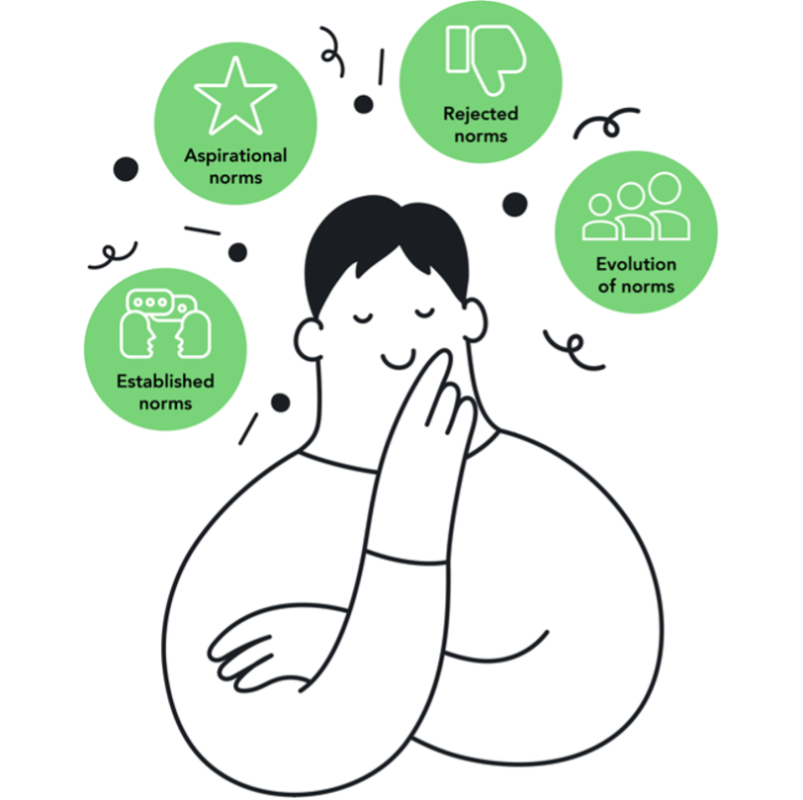Behavioural Tech-heads is a monthly series on Research World looking into what the technology industry can learn from behavioural science. It will cover the biases – both cognitive and behavioural – and psychological principles that offer the greatest contribution to the tech industry.
Social norms
In this instalment of Behavioural Tech-heads we’ll be looking at social norms.
What’s it all about?
A norm is something that is usual, standard, or average. It’s what’s normal. In the context of behavioural science, we’re interested in social norms. Social norms refer to our tendency to do what those around us are already doing. They’re beliefs, attitudes, behaviours which we perceive to be normal.
How does it work?
Humans are social creatures. We’re hard-wired to seek membership to social groups. Behaving in line with social norms is what allows us to obtain and sustain membership. Our behaviour is kept in check via social sanctions for norm violation. No one wants to be the outcast, so we behave in ways which are socially approved. We’re naturally sensitive to how those around us interact with ourselves and our behaviour. This ensures membership to our social group(s) aren’t compromised.
Norms are deeply ingrained within our society. They’re learnt from an early age, both directly and indirectly. Directly, by being told – “please raise your hand if you want to speak”. And indirectly, through observing social sanctions – witnessing the child who picks their nose being left out. As we grow up and socialize more, we collect norms along the way. We learn what’s considered appropriate and normal, and what isn’t. The norms we ascribe to will often evolve throughout the life course due to their nature being dependent on those we surround ourselves with.
Social norms may be thought of as unwritten rules of society. The norms which we abide by vary across different social groups. For example:
- Cultural differences – some cultures view burping after a meal as polite, others view it as rude
- Age differences – not having a job is only seen as being ‘unemployed’ when of the normal working age range
- Gender differences – it’s a norm for a male to propose to a female, but not vice versa
- Temporal differences – smoking was a norm during the 1930’s. Today, this is no longer true
An example of social norms at play
Angelo Anastasio, a senior Adidas employee, famously capitalised on people’s desire to copy what others are doing to ‘fit in’.
By 1986 Run DMC, through the launch of two ground-breaking hip-hop albums, became the voice of urban youth throughout the US. Whilst attending one of their concerts at Madison Square Gardens, he was overwhelmed by the sight of thousands of fans holding their Adidas sneakers above their heads in response from a call from the stage.
He realised that change was afoot, and that this growing youth movement was using Adidas merchandise to be an outward projection of who they were, what they stood for, and to ‘fit in’ with the rest of the crowd.
The next day he made it his mission to get Run DMC to sign an endorsement contract with Adidas – knowing it would significantly grow their market share.

And that’s exactly what he did.
The impact was immediate. Sales of branded leisure wear and the ‘Superstar’ sneaker skyrocketed – with Adidas becoming a ‘hero brand’ for youths throughout the US. It became the norm to wear Adidas – and if you didn’t wear Adidas, you weren’t normal.
So, what’s the importance for the tech industry?
For tech brands to successfully leverage social norms, they to need to embed themselves in the world of their target audience – allowing them to understand who they are and what makes them tick in nuanced detail.
This is more than just understanding usage, behaviour and general outlook on life – this is about understanding the cultural, gender, or temporal norms they currently ascribe to or aspire to.

To do this, tech brand need to be able to answer the following questions.
- Established norms: What norms do they live by? How were they established? How have they evolved over time and what have been the driving factors of change?
- Aspirational norms: What norms do they aspire to fold into their life? Who’s the inspiration and how will it play out in their life?
- Rejected norms: What norms do they reject? What is their rationale? How likely is it that this will change and why?
- Evolution of norms: What future events (cultural, gender, or temporal) are going to affect how they see the world, themselves, and their social circles.
Once tech brands have these answers, they too, can have their own Angelo Anastasio moment.


